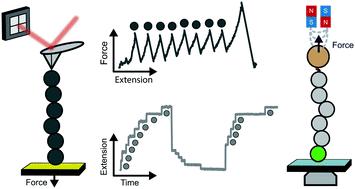当前位置:
X-MOL 学术
›
Chem. Soc. Rev.
›
论文详情
Our official English website, www.x-mol.net, welcomes your
feedback! (Note: you will need to create a separate account there.)
The nanomechanics of individual proteins.
Chemical Society Reviews ( IF 40.4 ) Pub Date : 2020-09-15 , DOI: 10.1039/d0cs00426j Marc Mora 1 , Andrew Stannard , Sergi Garcia-Manyes
Chemical Society Reviews ( IF 40.4 ) Pub Date : 2020-09-15 , DOI: 10.1039/d0cs00426j Marc Mora 1 , Andrew Stannard , Sergi Garcia-Manyes
Affiliation

|
Mechanical forces regulate a large variety of cellular functionalities, encompassing e.g. motility, differentiation and muscle contractility. To adapt to the dynamic change in mechanical stress, the constitutive individual proteins need to reversibly stretch and recoil over long periods of time. Yet, the molecular mechanisms controlling the mechanical unfolding and refolding of proteins cannot be accessed by protein folding biochemistry experiments conducted in the bulk, because they cannot typically apply forces to individual proteins. The advent of single-molecule nanomechanical techniques, often combined with bespoke protein engineering strategies, has enabled monitoring the conformational dynamics of proteins under force with unprecedented length-, time- and force-resolution. This review focuses on the fundamental operational principles of the main single-molecule nanomechanical techniques, placing particular emphasis on the most common analytical approaches used to extract information directly from the experiments. The breadth of enabling applications highlights the most exciting and promising outputs from the nanomechanics field to date.
中文翻译:

单个蛋白质的纳米力学。
机械力调节多种细胞功能,包括例如运动,分化和肌肉收缩。为了适应机械应力的动态变化,组成型单个蛋白质需要长时间可逆地拉伸和反冲。然而,通过大量进行的蛋白质折叠生物化学实验无法控制蛋白质的机械展开和再折叠的分子机制,因为它们通常无法对单个蛋白质施加力。单分子纳米机械技术的出现,通常与定制的蛋白质工程策略相结合,使得能够以前所未有的长度,时间和力分辨率监测受力蛋白质的构象动力学。这篇评论着重于主要的单分子纳米机械技术的基本操作原理,特别强调最直接用于从实验中提取信息的最常用分析方法。支持应用的广度突出了迄今为止纳米力学领域最令人兴奋和最有希望的输出。
更新日期:2020-10-05
中文翻译:

单个蛋白质的纳米力学。
机械力调节多种细胞功能,包括例如运动,分化和肌肉收缩。为了适应机械应力的动态变化,组成型单个蛋白质需要长时间可逆地拉伸和反冲。然而,通过大量进行的蛋白质折叠生物化学实验无法控制蛋白质的机械展开和再折叠的分子机制,因为它们通常无法对单个蛋白质施加力。单分子纳米机械技术的出现,通常与定制的蛋白质工程策略相结合,使得能够以前所未有的长度,时间和力分辨率监测受力蛋白质的构象动力学。这篇评论着重于主要的单分子纳米机械技术的基本操作原理,特别强调最直接用于从实验中提取信息的最常用分析方法。支持应用的广度突出了迄今为止纳米力学领域最令人兴奋和最有希望的输出。











































 京公网安备 11010802027423号
京公网安备 11010802027423号